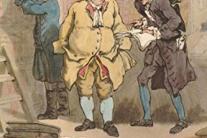The University of Louisiana at Lafayette has taken its place in the top level of the nation’s research institutions
Novel Ventures Redesigns Fiction Genre Studies
Tue, 10/24/2017 - 12:45pmIn her debut book, "Novel Ventures," Dr. Leah Orr is reshaping how the origin of English fiction will be taught in classrooms after discovering new evidence on the creation of the genre.
The book, now available for purchase, reviews almost 500 works of fiction printed from 1690 to 1730 and reveals it was the publishers, rather than the writers — as scholarly texts have generally claimed — who had far more influence over the development of English fiction.
“It’s always been presented like, ‘Here are the five big novels that changed everything,’” explained Orr, an assistant professor of English. “This wasn’t a few genius authors inventing a new genre. This was publishers choosing what to publish for an audience who was going to buy certain stuff. This was an experimental era when they didn’t know what was going to sell.”
Originally fascinated by how a genre is invented, Orr began reading historical texts on the introduction of the novel.
Then she wondered: How would it feel to step into a bookstore in the year 1710?
“What would be on the shelf? Why would you pick one thing and not another? How would you know if something was fiction and not fact?” she questioned.
What Orr said she found for sale were generally reprints of older publications, translated texts from France and Spain, or publications that would contemporarily be considered fictional but were being promoted then as “true narrative” — an essay written with a plot and characters —, like "Robinson Crusoe" by Daniel Defoe.
But what ultimately led to fiction becoming a definitive genre were the large quantities of copycat novels of books that had found success.
When publishers realized what books were capturing the most interest, they’d request writers to produce more novels with similar themes, and the shelves would soon be littered with imitations attempting to exploit the original’s success.
For example, after Defoe’s wide success in 1719, novels like Penelope Aubin’s "The Noble Slaves" (1722) and Peter Longueville’s "The Hermit" (1727) — both castaway narratives like Defoe’s — gained moderate achievement.
Eventually, the vast collection of similarly written books that focused more on the author’s imagination and less so on factual correctness led to the birth of English fiction.
"Novel Ventures" has already received praise for its alternative approach to the research.
Dr. Pat Rogers, a professor from the University of South Florida, stated Orr “offers a sustained argument that challenges orthodoxy at almost every turn.”
From New York University, Dr. Paula McDowell wrote in her review, “This trailblazing study of the relationship between early novel and the publishing industry will help shape the contours of eighteenth-century fiction studies for decades to come.”

